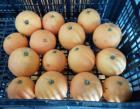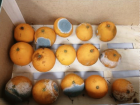Abstract
Research Article
Effect of chitosan and silicon oxide treatments on postharvest Valencia Late (Citrus × sinensis) fruits
Beltrán R*, Otesinova L, Cebrián N, Zornoza C, Breijo F, Reig J, Garmendia A and Merle H
Published: 06 October, 2021 | Volume 5 - Issue 3 | Pages: 065-071
The efficacy of chitosan and silicon oxide to prevent postharvest weight loss and fungi infection in 'Valencia Late' oranges was tested. Three silicon oxide concentrations (0.1%, 0.2%, 1%) were applied as preharvest treatments. Chitosan treatments were performed at the same concentrations in postharvest fruit. Preharvest applications were carried out by tractor spraying, while fruit were submerged for 30 seconds in baths with the chitosan concentrations in the postharvest applications. In both cases, a positive control (water treatment) and negative control (fungicide) were included. Treated fruit were stored in a chamber to simulate commercial storage conditions (4 ºC, 90% RH) for 9 weeks. After this time, the weight loss and damage caused by fungi due to natural infection were evaluated. Both silicon oxide and chitosan applications were effective in controlling natural infection by Penicillium species but had no positive effect on weight loss.
Read Full Article HTML DOI: 10.29328/journal.jpsp.1001063 Cite this Article Read Full Article PDF
Keywords:
Citrus; Oranges; Fruit disease; Penicillium digitatum; Penicillium italicum; Weight loss; Chitosan; Silicon oxide; Mancozeb; Imazalil
References
- Resource Database, Crops [WWW Document]. 2018. http://www.fao.org/faostat/en/#data/
- Liao HL, Alferez F, Burns JK. Assessment of blue light treatments on citrus postharvest diseases. Postharvest Biol Technol. 2013; 81: 81-88.
- Palou L. Penicillium digitatum, Penicillium italicum (green mold, blue mold). In Postharvest Decay. 2013; 45-102.
- Valencia‐Chamorro SA, Pérez‐Gago MB, Del Río MA, Palou L. Effect of Antifungal Hydroxypropyl Methylcellulose‐Lipid Edible Composite Coatings on Penicillium Decay Development and Postharvest Quality of Cold‐Stored “Ortanique” Mandarins. J Food Sci. 2010; 75: S418-S426. PubMed: https://pubmed.ncbi.nlm.nih.gov/21535515/
- Chien PJ, Chou CC. Antifungal activity of chitosan and its application to control post‐harvest quality and fungal rotting of Tankan citrus fruit (Citrus tankan Hayata). J Sci Food Agricul. 2016; 86: 1964-1969.
- Plaza P, Sanbruno A, Usall J, Lamarca N, Torres R, et al. Integration of curing treatments with degreening to control the main postharvest diseases of clementine mandarins. Postharvest Biol Technol. 2004; 34: 29-37.
- Shiekh RA, Malik MA, Al-Thabaiti SA, Shiekh MA. Chitosan as a novel edible coating for fresh fruits. Food Sci Technol Res. 2013; 19: 139-155.
- Lafuente MT, Alférez F, Romero P. Postharvest ethylene conditioning as a tool to reduce quality loss of stored mature sweet oranges. Postharvest Biol Technol. 2014; 94: 104-111.
- Bautista-Baños S, Hernández-Lauzardo AN, Velázquez-Del Valle MG, Hernández-López M, Barka EA, et al. Chitosan as a potential natural compound to control pre and postharvest diseases of horticultural commodities. Crop Protection. 2006; 25: 108-118.
- Chien PJ, Sheu F, Lin HR. Coating citrus (Murcott tangor) fruit with low molecular weight chitosan increases postharvest quality and shelf life. Food Chemistry. 2007; 100: 1160-1164.
- Galed G, Fernández-Valle ME, Martínez A, Heras A. Application of MRI to monitor the process of ripening and decay in citrus treated with chitosan solutions. Magne Resona Imag. 2004; 22: 127-137.
- Romanazzi G, Karabulut OA, Smilanick JL. Combination of chitosan and ethanol to control postharvest gray mold of table grapes. Postharvest Biol Technol. 2007; 45: 134-140.
- Hong K, Xie J, Zhang L, Sun D, Gong D. Effects of chitosan coating on postharvest life and quality of guava (Psidium guajava L.) fruit during cold storage. Scientia Horticulturae. 2012; 144: 172-178.
- Han C, Zuo J, Wang Q, Xu L, Zhai B, et al. Effects of chitosan coating on postharvest quality and shelf life of sponge gourd (Luffa cylindrica) during storage. Sci Horticultur. 2014; 166: 1-8.
- Gol NB, Patel PR, Rao TR. Improvement of quality and shelf-life of strawberries with edible coatings enriched with chitosan. Postharvest Biol Technol. 2013; 85: 185-195.
- El Ghaouth A, Ponnampalam R, Castaigne F, Arul J. Chitosan coating to extend the storage life of tomatoes. HortScience. 1992; 27: 1016-1018.
- Zeng K, Deng Y, Ming J, Deng L. Induction of disease resistance and ROS metabolism in navel oranges by chitosan. Sci Horticultur. 2010; 126: 223-228.
- Arnon H, Zaitsev Y, Porat R, Poverenov E. Effects of carboxymethyl cellulose and chitosan bilayer edible coating on postharvest quality of citrus fruit. Postharvest Biol Technol. 2014; 87: 21-26.
- El Guilli M, Hamza A, Clément C, Ibriz M, Ait Barka E. Effectiveness of postharvest treatment with chitosan to control citrus green mold. Agriculture. 2016; 6: 12.
- Sánchez-González L, Cháfer M, Chiralt A, González-Martínez C. Physical properties of edible chitosan films containing bergamot essential oil and their inhibitory action on Penicillium italicum. Carbohydrate Polymers. 2010; 82: 277-283.
- Kean T, Thanou M. Biodegradation, biodistribution and toxicity of Adv Drug Deliv Rev. 2010; 62: 3-11. PubMed: https://pubmed.ncbi.nlm.nih.gov/19800377/
- Saberi B, Golding JB, Marques JR, Pristijono P, Chockchaisawasdee S, et al. Application of biocomposite edible coatings based on pea starch and guar gum on quality, storability and shelf life of ‘Valencia’ oranges. Postharvest Biol Technol. 2018; 137: 9-20.
- He L, Liu Y, Mustapha A, Lin M. Antifungal activity of zinc oxide nanoparticles against Botrytis cinerea and Penicillium expansum. Microbiol Res. 2011; 166: 207-215. PubMed: https://pubmed.ncbi.nlm.nih.gov/20630731/
- Sawai J, Yoshikawa T. Quantitative evaluation of antifungal activity of metallic oxide powders (MgO, CaO and ZnO) by an indirect conductimetric assay. J Appl Microbiol. 2004; 96: 803-809. PubMed: https://pubmed.ncbi.nlm.nih.gov/15012819/
- Bi Y, Tian SP, Guo YR, Ge YH, Qin GZ. Sodium silicate reduces postharvest decay on Hami melons: induced resistance and fungistatic effects. Plant Dis. 2006; 90: 279-283. PubMed: https://pubmed.ncbi.nlm.nih.gov/30786549/
- Guo Y, Liu L, Zhao J, Bi Y. Use of silicon oxide and sodium silicate for controlling Trichothecium roseum postharvest rot in Chinese cantaloupe (Cucumis melo L.). Int J Food Sci Technol. 2007; 42: 1012-1018.
- Elsherbiny EA, Taher MA. Silicon induces resistance to postharvest rot of carrot caused by Sclerotinia sclerotiorum and the possible of defense mechanisms. Postharvest Biol Technol. 2018; 140: 11-17.
- Mohamed MAA, El-khalek AFA, Elmehrat HG. Pre-harvest Potassium Silicate, Chitosan and calcium chloride Application Improves Mango Fruits (Zebda Cv.) Quality and Storability. Egyptian J Horticulture. 2017; 44: 17-32.
- Liu J, Zong Y, Qin G, Li B, Tian S. Plasma membrane damage contributes to antifungal activity of silicon against Penicillium digitatum. Curr Microbiol. 2010; 61: 274-279. PubMed: https://pubmed.ncbi.nlm.nih.gov/20195609/
- Moscoso-Ramírez PA, Palou L. Preventive and curative activity of postharvest potassium silicate treatments to control green and blue molds on orange fruit. Eur J Plant Pathol. 2014; 138: 721-732.
- Yun JW, Kim SH, You JR, Kim WH, Jang JJ, et al. Comparative toxicity of silicon dioxide, silver and iron oxide nanoparticles after repeated oral administration to rats. J Appl Toxicol. 2015;35: 681-693. PubMed: https://pubmed.ncbi.nlm.nih.gov/25752675/
- R Core Team. R: A Language and Environment for Statistical Computing. Vienna: R Foundation for Statistical Computing. https://www.R-proyect.org
- RStudio Team. RStudio: Integrated Development for R. RStudio, Inc, Boston, MA. 2016. http://www.rstudio.com
- Holm S. A Simple Sequentially Rejective Multiple Test Procedure. Scandinavian J Statist. 1979; 65-70.
- Hernández JF, Ruiz JM, Félix AR. Efecto de recubrimiento con Quitosano y cera comercial en la calidad de naranja 'valencia' durante el almacenamiento. Revista Iberoamericana de Tecnología Postcosecha. 2011; 12: 164-174.
- García-Saucedo C, Field JA, Otero-González L, Sierra-Álvarez R. Low toxicity of HfO2, SiO2, Al2O3 and CeO2 nanoparticles to the yeast, Saccharomyces cerevisiae. J Hazard Materials. 2011; 192: 1572-1579. PubMed: https://pubmed.ncbi.nlm.nih.gov/21782338/
- Karimiyan A, Najafzadeh H, Ghorbanpour M, Hekmati-Moghaddam SH. Antifungal effect of magnesium oxide, zinc oxide, silicon oxide and copper oxide nanoparticles against Candida albicans. Zahedan J Res Med Sci. 2015;17: 19-23.
- Youssef K, Ligorio A, Sanzani SM, Nigro F, Ippolito A. Control of storage diseases of citrus by pre-and postharvest application of salts. Postharvest Biol Technol. 2012; 72: 57-63.
- Ruffo-Roberto S, Youssef K, Hashim AF, Ippolito A. Nanomaterials as alternative control means against postharvest diseases in fruit crops. Nanomaterials. 2019; 9: 1752. PubMed: https://pubmed.ncbi.nlm.nih.gov/31835458/
- Sánchez-González L, Vargas M, González-Martínez C, Chiralt A, Chafer M. Use of essential oils in bioactive edible coatings: a review. Food Engineer Rev. 2011; 3: 1-16.
- Epstein E. Silicon. Annu Rev Plant Physiol Plant Mol Biol. 1999; 50: 641-664. PubMed: https://pubmed.ncbi.nlm.nih.gov/15012222/
- Li YH, Bi Y, Zhang HY, Ge YH, Liu J. Inhibiting effect of postharvest sodium silicate treatment on blue mould of pear (cv. Pingguoli). J Gansu Agri Univers. 2008; 6: 33.
Figures:

Figure 1

Figure 2

Figure 3

Figure 4

Figure 5

Figure 6
Similar Articles
-
Control of phytopathogenic microorganisms of post-harvest in tomato (Lycopersicon esculentum Mill.) with the use of citrus extractRueda Puente Edgar Omar*,Ruíz-Alvarado Cristina,Juan José Reyes-Pérez,Hernández-Montiel Luis Guillermo,Amador Bernardo. Control of phytopathogenic microorganisms of post-harvest in tomato (Lycopersicon esculentum Mill.) with the use of citrus extract. . 2018 doi: 10.29328/journal.jpsp.1001018; 2: 037-043
-
Nematicidal effect of abamectin, boron, chitosan, hydrogen peroxide and Bacillus thuringiensis against citrus nematode on Valencia orangSherin FA Awd Allah*,Sandy E Hammad,MAM El-Saedy. Nematicidal effect of abamectin, boron, chitosan, hydrogen peroxide and Bacillus thuringiensis against citrus nematode on Valencia orang. . 2019 doi: 10.29328/journal.jpsp.1001041; 3: 111-117
-
Gene polymorphisms CVPDr on some plants citrus in Bali IslandI Ketut Widnyana*,I Gusti Ayu Diah Yuniti,I Gede Putu Wirawan,I Nyoman Wijaya,Made Sritamin. Gene polymorphisms CVPDr on some plants citrus in Bali Island. . 2020 doi: 10.29328/journal.jpsp.1001049; 4: 036-041
-
Antiviral and Antinematodal potentials of chitosan: ReviewMahmoud Hamdy Abd El-Aziz*,Mohamed Salah Khalil. Antiviral and Antinematodal potentials of chitosan: Review. . 2020 doi: 10.29328/journal.jpsp.1001051; 4: 055-059
-
Pathogen identification and control of sooty spot caused by Cladosporium ramotenellum, appearing on fresh easy peeler mandarins from PerúCelia Murciano*,Benito Orihuel-Iranzo,Jeniffer J Oliver-Chirito. Pathogen identification and control of sooty spot caused by Cladosporium ramotenellum, appearing on fresh easy peeler mandarins from Perú. . 2021 doi: 10.29328/journal.jpsp.1001059; 5: 044-052
-
Effect of chitosan and silicon oxide treatments on postharvest Valencia Late (Citrus × sinensis) fruitsBeltrán R*,Otesinova L,Cebrián N,Zornoza C,Breijo F,Reig J,Garmendia A,Merle H. Effect of chitosan and silicon oxide treatments on postharvest Valencia Late (Citrus × sinensis) fruits. . 2021 doi: 10.29328/journal.jpsp.1001063; 5: 065-071
-
Post-harvest assessment of infectious fruit rot on selected fruits in Lafia, Nasarawa State NigeriaEH Kwon-Ndung*,TP Terna,EE Goler,G Obande. Post-harvest assessment of infectious fruit rot on selected fruits in Lafia, Nasarawa State Nigeria. . 2022 doi: 10.29328/journal.jpsp.1001090; 6: 154-160
Recently Viewed
-
Drug Rehabilitation Centre-based Survey on Drug Dependence in District Shimla Himachal PradeshKanishka Saini,Palak Sharma,Bhawna Sharma*,Atul Kumar Dubey,Muskan Bhatnoo,Prajkta Thakur,Vanshika Chandel,Ritika Sinha. Drug Rehabilitation Centre-based Survey on Drug Dependence in District Shimla Himachal Pradesh. J Addict Ther Res. 2025: doi: 10.29328/journal.jatr.1001032; 9: 001-006
-
A Rare Case of Uvulitis Following Endotracheal Intubation Using C- Mac Videolaryngoscope and How To Avoid ItKiran Kuruvilla George, Jini Chirackel Thomas, Krishnan B Sivaram, Krishna Prasad T*. A Rare Case of Uvulitis Following Endotracheal Intubation Using C- Mac Videolaryngoscope and How To Avoid It. Arch Pathol Clin Res. 2024: doi: 10.29328/journal.apcr.1001043; 8: 016-020
-
Gossypiboma due to a retained surgical sponge following abdominal hysterectomy, complicated by intestinal migration and small bowel obstruction- A Case ReportVivek Agrawal,Praroop Gupta*. Gossypiboma due to a retained surgical sponge following abdominal hysterectomy, complicated by intestinal migration and small bowel obstruction- A Case Report. Arch Surg Clin Res. 2018: doi: 10.29328/journal.ascr.1001017; 2: 015-017
-
Laparoscopic Cholecystectomy: Challenges faced by beginners our perspectiveKunal Chowdhary,Gurinder Kaur,Kapil Sindhu,Muzzafar Zaman*,Aliya Shah,Rohit Dang,Ashish Kumar,Jose John Maiakal,Ashutosh Bawa. Laparoscopic Cholecystectomy: Challenges faced by beginners our perspective. Arch Surg Clin Res. 2018: doi: 10.29328/journal.ascr.1001018; 2: 018-024
-
Actinomycosis of the appendixLucas Wheatley*,Michael Lonne,James Bennnet,Bhavik Patel. Actinomycosis of the appendix. Arch Surg Clin Res. 2018: doi: 10.29328/journal.ascr.1001020; 2: 029-030
Most Viewed
-
Evaluation of Biostimulants Based on Recovered Protein Hydrolysates from Animal By-products as Plant Growth EnhancersH Pérez-Aguilar*, M Lacruz-Asaro, F Arán-Ais. Evaluation of Biostimulants Based on Recovered Protein Hydrolysates from Animal By-products as Plant Growth Enhancers. J Plant Sci Phytopathol. 2023 doi: 10.29328/journal.jpsp.1001104; 7: 042-047
-
Sinonasal Myxoma Extending into the Orbit in a 4-Year Old: A Case PresentationJulian A Purrinos*, Ramzi Younis. Sinonasal Myxoma Extending into the Orbit in a 4-Year Old: A Case Presentation. Arch Case Rep. 2024 doi: 10.29328/journal.acr.1001099; 8: 075-077
-
Feasibility study of magnetic sensing for detecting single-neuron action potentialsDenis Tonini,Kai Wu,Renata Saha,Jian-Ping Wang*. Feasibility study of magnetic sensing for detecting single-neuron action potentials. Ann Biomed Sci Eng. 2022 doi: 10.29328/journal.abse.1001018; 6: 019-029
-
Pediatric Dysgerminoma: Unveiling a Rare Ovarian TumorFaten Limaiem*, Khalil Saffar, Ahmed Halouani. Pediatric Dysgerminoma: Unveiling a Rare Ovarian Tumor. Arch Case Rep. 2024 doi: 10.29328/journal.acr.1001087; 8: 010-013
-
Physical activity can change the physiological and psychological circumstances during COVID-19 pandemic: A narrative reviewKhashayar Maroufi*. Physical activity can change the physiological and psychological circumstances during COVID-19 pandemic: A narrative review. J Sports Med Ther. 2021 doi: 10.29328/journal.jsmt.1001051; 6: 001-007

HSPI: We're glad you're here. Please click "create a new Query" if you are a new visitor to our website and need further information from us.
If you are already a member of our network and need to keep track of any developments regarding a question you have already submitted, click "take me to my Query."















































































































































